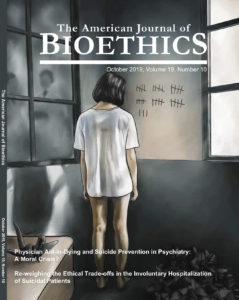This post is presented in collaboration with the American Journal of Bioethics.
You can read the entire issue by clicking here.
by Dan Diaz
My wife, Brittany Maynard, died on November 1, 2014, of a brain tumor, but she used medical aid-in-dying to insure a peaceful death and end the unbearable suffering when no other option would provide relief. After Brittany was diagnosed in January 2014, she endured an eight-hour brain surgery and we researched every treatment option that offered any hope of extending her life. But the brain tumor was growing aggressively. Brittany’s doctors informed her she had six months to live. She was only 29 years old.
Brittany’s case received a lot of media attention because we had to move from our home in California to Oregon just so she could have the option of a gentle dying process utilizing Oregon’s medical aid-in-dying law, if it were to become necessary for her.

Brittany publicly spoke up during the last few weeks of her life to expand medical aid-in-dying laws to more states, including California. She decided to advocate for this cause by speaking her truth in a six minute video that captured the attention of the nation. Her hope was to help any terminally ill individual in her predicament, so they would never have to relocate like we did in order to access medical aid-in-dying to peacefully end their suffering. At that time there were only four states that afforded a terminally ill individual this option: Oregon, Washington, Vermont, and Montana.
Brittany did not make this decision lightly. Very judiciously, she researched and carefully considered the benefits and ethics of this vital legislation to our broader society, as well as any potential harms. It was just her nature to be that thorough.
Before deciding to open our lives to the scrutiny of the media and public opinion, she considered the impact this legal option would have on people from all walks of life: patients, doctors, legislators, religious groups, etc. But after navigating the process of applying for the medication and experiencing firsthand the rigorous safeguards that were in place, it reinforced her resolve to advocate for this medical option. She recognized the enormous benefits it affords terminally ill individuals and our society as a whole.
The mere existence of this legislation, for the first time, protects the most vulnerable.
It brings the conversation about a terminally ill individual’s approaching death into the open. It forces the conversation into the light of day and avoids the tragic cases of patient’s or family members taking desperate measures behind closed doors. It gives a physician the chance to address the fears and concerns of a patient who may not even currently qualify for medical aid-in-dying, by simply affording that doctor the opportunity to identify and address unmet needs of that patient’s care.
In keeping my promise to Brittany and to honor her legacy, I have traveled to 14 state capitols across the country to advocate for the passage of this legislation. (There are now ten jurisdictions that have passed this law, the additional six are: California, Colorado, Hawai‘i, New Jersey, Maine, and Washington D.C.)
My mission is to improve end of life care for terminally ill individuals. The two basic components I advocate for:
Increasing investment and expanding the availability of quality hospice and palliative care, so that all patients receive gold standard level of care.
Passing medical aid-in-dying bills, so terminally ill individuals, like Brittany, have the option when modern medicine is no longer able to prevent that person from suffering.
The legislation Brittany advocated for, and which I continue to support, includes the important parameters that a person who qualifies must be mentally capable of making their own healthcare decisions, as confirmed by two physicians, and able to self-ingest the medication. Each of the existing U.S. statutes uniformly require that recipients of medical aid-in-dying not be suffering from impaired judgment due to a mental illness.
To be clear, Brittany, and any terminally ill individual in her situation, is not choosing between living and dying. The brain tumor was ending Brittany’s life. The option of living was no longer available to her. She was only choosing between two different methods of dying. One method would be gentle, peaceful. The other would result in being tortured to death by the increasingly intense symptoms she was already experiencing: unrelenting pain, nausea, sleep deprivation, seizures, and impending blindness and paralysis. Those were her reasons for moving to Oregon to have this option available to her.
 It is offensive when opponents attempt to downplay or ignore the very real symptoms she endured. Only the patient truly knows how much suffering is being experienced. The adage applies: “don’t judge someone until you’ve walked a mile in their moccasins.”
It is offensive when opponents attempt to downplay or ignore the very real symptoms she endured. Only the patient truly knows how much suffering is being experienced. The adage applies: “don’t judge someone until you’ve walked a mile in their moccasins.”
As a 29-year-old terminally ill individual, Brittany captured the attention of the nation because she represents any one of us. She could have been your sister, niece, cousin, daughter, mother, or wife.
People lose sight of this simple truth: Brittany’s story is not about death and dying, it’s about life and living. She lived her life on her terms. In the end she did not die as a ‘victim’ to cancer. She died in the same way she experienced life; with grace, compassion, and love.
I walked the journey with Brittany during those ten months of navigating the chaos that cancer introduces into a family’s sphere. Early on, I became keenly aware that suffering is so much more than just physical pain.
So while I continue to advocate for legislation that includes the safeguards of a six-month terminal prognosis, mental capability, and the ability to self-ingest the medication. I can imagine there might be cases when an individual may be experiencing unremitting emotional distress, no, emotional devastation.
Since I have not walked that path, I will neither judge nor condemn an individual who pursues separate options to address those circumstances. At the same time I hope others will not judge terminally ill individuals and healthcare professionals who rightly believe medical aid-in-dying is an ethical medical practice that offers relief from intolerable suffering when no other option will provide it.